Notes: On 1 July 1852 the St Helens Canal and Railway Company (SHC&RC) opened a line from Runcorn Gap (Widnes) to Garston. The line was an extension of their St Helens and Runcorn Gap line that had opened in February 1833 and provided access to the River Mersey at Garston Dock from where larger vessels could operate. The 1833 line connected to Widnes Dock which was just to the east of the Runcorn Gap (a narrow point in the River Mersey over which a ferry operated) that was constrained by tides.
When the Garston line opened a new Runcorn Gap passenger station was provided on it on the west side of Waterloo Road. Goods facilities were provided adjacent to the station on its south side.
 |
At the time of opening it is likely that the goods facilities were fairly simple. Later maps show a rail-connected shed on Waterloo Road that certainly dated from the 1850s.
On 1 February 1853 a line from Runcorn Gap to a temporary station at Warrington White Cross was opened (being extended to Warrington Arpley and connecting end-on with the Warrington & Stockport Railway on 1 May 1854). This created the Garston and Warrington Railway, and a through route to the Manchester area. The Warrington & Garston and the St Helens & Runcorn Gap lines crossed at right angles on the level at what later became Widnes Dock Junction, less than half a mile east of the passenger and goods station.
Industrial development was rapid on the north side of the River Mersey at Runcorn Gap during the decades following 1852, and by 1864 the township of Widnes had been formed.
On 1 September 1864 the London & North Western Railway (LNWR) took over the SHC&RC - having held a lease on the Garston and Warrington line since 1 September 1860. They renamed the passenger and goods station ‘Widnes’. By this time the goods facilities at Widnes had expanded. Hutchinson Street had been laid out to the south of the railway and running parallel to it. By this time the main entrance to the goods station was off Hutchinson Street.
 The LNWR invested £100,000 at Widnes making improvements. The biggest single improvement was the creation of the Widnes Deviation Railway. The line was 1¼ miles long and diverged from the original route 15 chains to the west of the goods station at what became Widnes West Deviation Junction. It then ran to the north of the original route, climbing to an elevated position that allowed it to bridge the St Helens line. It then dropped down to the original route at what became Carterhouse Junction. The line allowed through traffic to cross over the St Helens line without causing congestion. The deviation opened to goods services on 1 April 1869. A new passenger station was opened on the deviation on 1 March 1870. It was located only a short distance north of the original but on the east side of the road. When the new station opened the original was closed. The LNWR invested £100,000 at Widnes making improvements. The biggest single improvement was the creation of the Widnes Deviation Railway. The line was 1¼ miles long and diverged from the original route 15 chains to the west of the goods station at what became Widnes West Deviation Junction. It then ran to the north of the original route, climbing to an elevated position that allowed it to bridge the St Helens line. It then dropped down to the original route at what became Carterhouse Junction. The line allowed through traffic to cross over the St Helens line without causing congestion. The deviation opened to goods services on 1 April 1869. A new passenger station was opened on the deviation on 1 March 1870. It was located only a short distance north of the original but on the east side of the road. When the new station opened the original was closed.
The original passenger station was quickly demolished and its site was taken over by the goods department who extended sidings onto its site. The LNWR also built a large goods shed with offices on the south side of the line at the Hutchinson Street entrance. It was a brick shed with slate roof. Stables were incorporated into the building as horses were used for moving wagons around the yard.
The LNWR also opened an engine shed at Widnes in 1874 located to the north of Widnes Dock Junction and adjacent to the Widnes Deviation line on its south side. The shed provided the motive power for Widnes Goods.
By the mid 1880s the facilities at Widnes Goods were extensive. Two lines ran into the goods shed, one of which continued through it and headed east into the original shed. Situated on this line between the two sheds there was a lifting crane. To the west of the shed there were eight sidings, five of which had loading ramps at the eastern end. To the north of the shed there were two sidings followed by the main line of the original Garston & Warrington Railway. The eastern extent of the goods station was at Waterloo Road where the line continued on to Widnes Dock Junction via a level crossing. North of the main line there were a further sixteen sidings and, beyond them, the deviation line which was on an embankment.
To the west of the goods station the Hutchinson Dock Estate Railway, opened in stages from 1864, curved in from the south and made a connection with the LNWR lines. At the junction there were further sidings that facilitated transfer between the two systems.
Further west again was Widnes West Deviation Junction, the point at which the original and the deviation lines converged. This was also the westernmost extent of the Widnes Goods facilities although there were more sidings to the west of the junction.
Widnes Goods would have handled all manner of traffic, but inbound coal and outbound products of the chemical industry would have dominated.
Little changed over the following decades but the line into the original shed was cut back from it, and the crane was relocated to the north side of the goods shed.
Widnes Goods became part of the London Midland & Scottish Railway (LMS) on 1 January 1923 and of British Railways London Midland Region on 1 January 1948.
During the 1950s and into the ‘60s the yard continued to handle a variety of traffic. The ICI Marsh Works site received spent oxide deliveries, via Jubilee sidings. This was a sulphur rich waste product from town gas purification, used in the manufacture of sulphuric acid. Other sites serviced were ICI Gaskell Deacon site, ICI Muspratt site, Albright and Wilson’s, Viaduct Alum Works, McKechnie Brothers Chemicals, William Evans timber Yard, Birmingham Corrugated Iron Company, and Fisons.
Since 1940 train loads of coal from Yorkshire were brought to the yard and then worked forward to Weston Point power station in Runcorn as trip workings that were given the number Target 92. Six trip workings in every 24 hours were made from the yard to the power station. Coal was also supplied to the ICI Power Station at West Bank, and delivered via Hutchinson’s dock estate railway, employing their diesel shunter, or Avonside 0-6-0 “Lucy”. W.J.Bush and Company’s West Bank works (latterly Albright and Wilson, then Tessenderloo) also had a rail connection which was still in use during the 60’s.
During the same period there were regular mixed freight trips from the yard To ICI Pilkington Sullivan works, via the flat crossing at Widnes Dock Junction.
In 1962 ‘Dapple’, the last horse to be based at Widnes Goods, was transferred to Deansgate in Manchester. The departure of Dapple was significant enough to be reported in the local press.
McKechnie Brothers, a copper refining company, was located adjacent to Desoto Road and Ditton Road. During the 60’s their rail link, just north of West Deviation box, was regularly used, and serviced by a company owned Barclay 0-4-0 called “Efficient”. In the early 70’s this was disposed of. It is not know if there was ant significant activity after this date.
The biggest changes occurred in the late 1960s. Widnes Goods closed to public services on 31 March 1969. The original Garston & Warrington line through Widnes had closed as a through route on 10 March 1969. The main line was cut on the western side of Waterloo crossing and buffer stops were erected. The former up and down lines became up and down main sidings.
The yard, from this point on referred to more generally as Hutchinson Street or Widnes West Deviation sidings, remained open, but over the following years it was much rationalised. With the exception of one short length of line the Hutchinson Dock Estate Railway closed in 1971. The connections between it and the British Railways line were lifted as were the sidings that had allowed transfer of wagons. The sidings immediately to the west of the goods station were also lifted and their site, along with the goods shed, was sold to a private user. The new owners created a depot for the delivery of new cars, which were delivered to the facility by rail until the early 1980s.
Staff were still based at the yard in the form of shunters and train crew. A mess block was retained at the western end of the yard to accommodate them. The Widnes-based staff were responsible for a number of trip workings to local industries in the town. Initially two Class 08 locomotives were allocated to the yard from Allerton Depot. They were used for shunting at the yard and for trip workings. By the mid-1970s only one locomotive was needed. The locos were usually stabled at the western end of the yard near to where the mess facilities were located. In 1977 a new road bridge opened at the western end of the yard and the yard’s engine was often stabled under it to protect it from inclement weather.
In 1971 the Target 92 coal trains ceased to run after the Weston Point power station converted to alternative fuels, primarily gas. During the 1970s the main source of traffic, other than the car trains, for Hutchinson Street yard was cement from Hope (Earles Sidings) in Derbyshire. The cement was brought in by a daily Monday-to-Friday train that was half ‘prestflow’ and half cement tanks. The wagons were put into Hutchinson Street yard and then tripped to two locations by one of the yards allocated 08 locomotives. The prestflow wagons went to Farnworth & Bold for the Turners Asbestos Cement Everite works. The cement tanks went to Tanhouse Lane yard for the Blue Circle cement company.
In 1978 Fisons still had their own loco that hauled ammonium nitrate tanks from Jubilee sidings to their plant on the dock estate. In that year purchased an ex BR class 02 0-4-0 shunter number D2858 which had formerly been used by Hutchinsons estate from 1970. Fisons traffic ended in 1981.
In summer 1981 the cement traffic to Farnworth & Bold ceased and the only regular traffic was the car trains and the Blue Circle cement trip working. There were, in the first half of the 1980s, on occasions other types of train including oil.
By the mid 1980s the car trains had ceased. With only the Blue Circle cement traffic Hutchinson Street yard was an unnecessary expense. In autumn1988 the remaining services were diverted to run to and from Ditton. The yard was formally closed in 1989.
In the mid 1990s a new road on an embankment was constructed through the site of the yard dissecting it. Only a few remains survived into the 21st century, including part of the staff mess facility, to show that there had ever been a yard at Hutchinson Street.
Ticket from Les Fifoot and route map by Alan Young
The 8D Association - Dedicated to promoting the history of South Lancashire and North Cheshire railways. Web Site
See also: Runcorn Gap, Widnes and Widnes South stations.
See: Widnes Dock Junction, Widnes Deviation Railway
and Widnes Locomotive Shed |

.jpg)
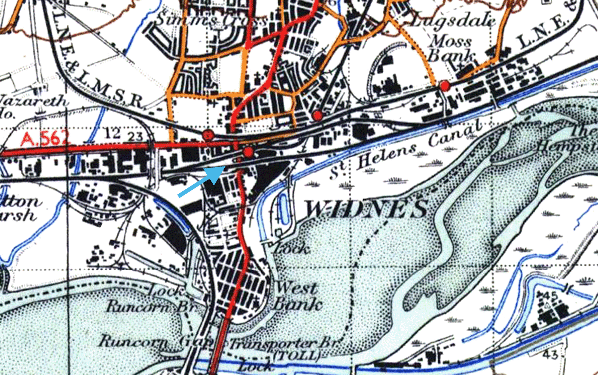
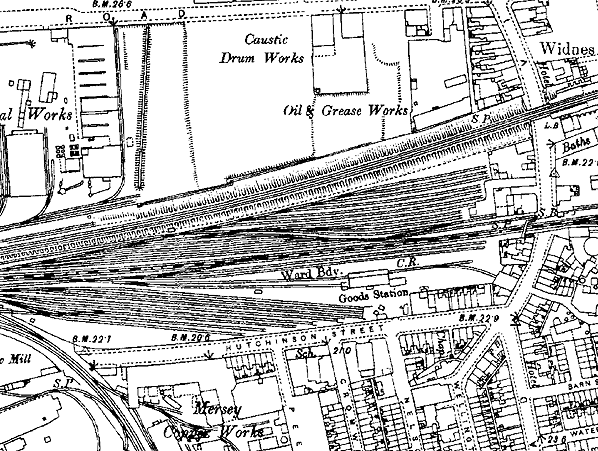
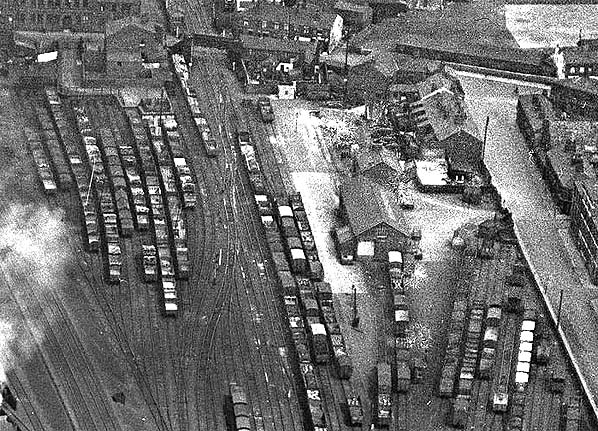
.jpg)

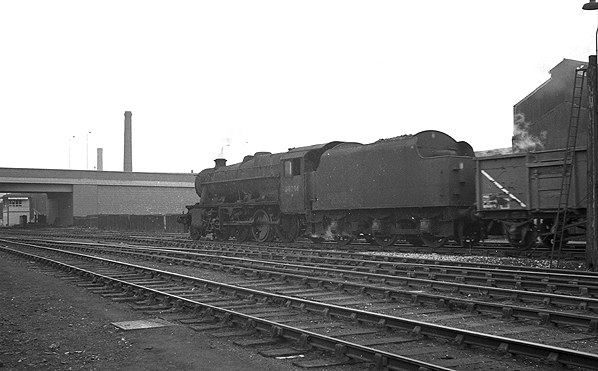


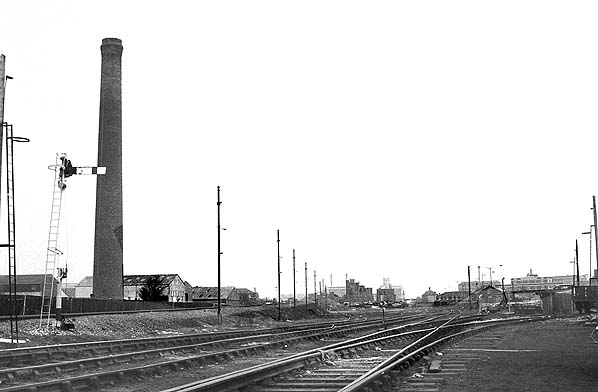
2.jpg)
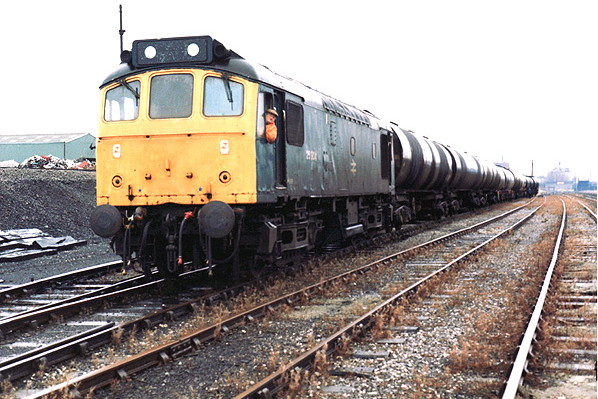
.jpg)
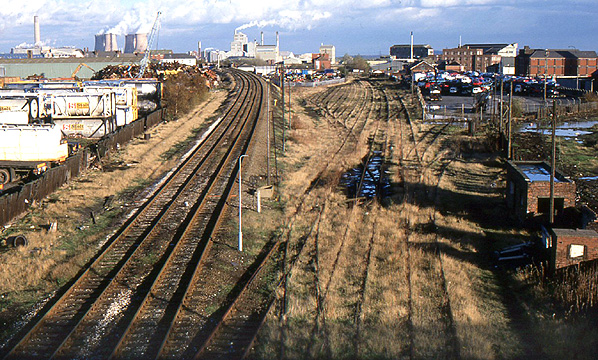
 Looking east at the site of Hutchinson Street yard in 8 January 2014 from the same
Looking east at the site of Hutchinson Street yard in 8 January 2014 from the same 
 The LNWR invested £100,000 at Widnes making improvements. The biggest single improvement was the creation of the Widnes Deviation Railway. The line was 1¼ miles long and diverged from the original route 15 chains to the west of the goods station at what became Widnes West Deviation Junction. It then ran to the north of the original route, climbing to an elevated position that allowed it to bridge the St Helens line. It then dropped down to the original route at what became Carterhouse Junction. The line allowed through traffic to cross over the St Helens line without causing congestion. The deviation opened to goods services on 1 April 1869. A new passenger station was opened on the deviation on 1 March 1870. It was located only a short distance north of the original but on the east side of the road. When the new station opened the original was closed.
The LNWR invested £100,000 at Widnes making improvements. The biggest single improvement was the creation of the Widnes Deviation Railway. The line was 1¼ miles long and diverged from the original route 15 chains to the west of the goods station at what became Widnes West Deviation Junction. It then ran to the north of the original route, climbing to an elevated position that allowed it to bridge the St Helens line. It then dropped down to the original route at what became Carterhouse Junction. The line allowed through traffic to cross over the St Helens line without causing congestion. The deviation opened to goods services on 1 April 1869. A new passenger station was opened on the deviation on 1 March 1870. It was located only a short distance north of the original but on the east side of the road. When the new station opened the original was closed.




.jpg)

 Home Page
Home Page